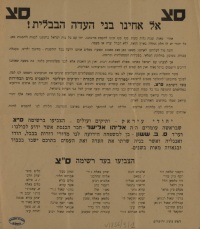Uniform Education
There have been various streams of education in the State of Israel since its inception. Parents could choose whether to send their children to the general education system, the workers' system, the Mizrahi system or that of Agudat Yisrael. Israelis had this freedom even prior to the 1953 legislation of the State Education Law. In the early years of the state however, the immigrant camps were the exception.
Mass immigration to the young state compelled the authorities to house many immigrants in temporary camps. In these camps, all children were given the same education, regardless of traditions, customs or religious affiliation. This was part of a "melting pot" policy according to which the immigrant was to assume a new, Israeli, identity upon arrival in Israel, shedding the old "diaspora" self. This uniform education was imposed on the immigrants in the camps.
Complaints about this uniform education soon arose. The religiously observant immigrants from Yemen felt particularly slighted. The uniform education was far removed from what they were accustomed to. Girls and boys studied together; the emphasis was on civil "sabra" studies with a view to helping the young generation adapt to life in the modern state.
The uniform education issue quickly became the center of a political outcry. In December 1949, MK David Tsvi submitted an inquiry to Prime Minister David Ben Gurion, in which he claimed that the state was guilty of religious coercion, an inquisition, in that it exploited the circumstances in which the immigrants in the camps found themselves. The public outcry worsened and in 1950 Ben Gurion convened a commission of inquiry headed by Judge Emeritus Gad Frumkin. The commission's conclusions were presented on May 9, 1950, and not only contained sharp critique of the uniform education system, but also on how it was implemented, especially with regard to immigrant children. The commission determined that cutting of the side locks of the immigrant children was systematic, but that Torah education was systematically undermined and observance of the Sabbath and prayer systematically interrupted. Although the commission acknowledged that these findings were not the result of intentional religious coercion, it declared that education in the camps had not been implemented in an acceptable manner and was even tainted with partisan interests. It denounced the neglect of religious education in the immigrant camps.
As a result of the findings of the Frumkin Commission, which is considered the first state commission of inquiry in Israel (though the law regarding commissions of inquiry had yet to be enacted), the Mapai party reached an agreement with the religious alliance regarding separate education for Yemenite children in the camps. Still, the report remained at the center of political disputes in the Knesset and the crisis between the Mapai and the religious alliance deepened, ultimately leading to elections for the second Knesset.
|
|
  |
Conscription of Women
The Security Service Law of 1949 declared conscription compulsory for the entire population of the State of Israel, including women. With this, the State of Israel became the only country in the world to require women to do military service. The law was fiercely opposed by the religious public and the parties that represented it. David Ben Gurion, however, stood his ground and refused to exempt religious women from conscription. It was however, determined that women would be permitted to declare that for reasons of conscience or religious recognition, they were prohibited from serving in the IDF. This was far from a solution. The option of obtaining exemption on the basis of a declaration alone made it possible for many women to avoid serving, and the issue has remained one of concern in Israeli society from 1949 to this very day.
The dispute over women serving in the IDF is rooted in the early days of Zionism. From the first settlements and pioneering youth movements, to the War of Independence, many women were actively involved as guards, soldiers and even commanders. In 1948, when the IDF was established, the women's army was set up. The intention was that women would guard settlements, fill combat support roles and administrative positions, but not engage in combat. The need arose to formalize the issue of women's military service in legislation.
Many religious groups saw the conscription of women as a tangible threat to religious society and a contravention of ancient traditions and principles. The issue quickly became the focus of dispute between the secular parties, led by Mapai, and the religious parties, some of whom were part of the first Mapai government. Naturally, the question of conscription of women was a central issue in the run up to the 1951 elections for the second Knesset. |
|
  |
